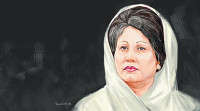Columns
Ending the science-policy gap
There should be a science-based policymaking process in disaster risk reduction.
Shrijan Bahadur Malla
According to the International Federation of Red Cross and Red Crescent Societies World Disaster Report 2020, extreme weather and climate-related disasters have killed 410,000 people worldwide in the last 10 years. Today, the rate of disaster events has increased by 35 percent compared to the 1990s, and almost 77 percent of them are climate related. The United Nations Environment Programme has reported that world temperatures will increase by 3 degrees Celsius by the end of this century if greenhouse gas emissions are not slashed by 7.6 percent. By then, the frequency and effects of droughts, storms, heat waves, rising sea levels, melting glaciers and warming oceans will rise manifold, and poor countries like Nepal will be affected the most.
When climate change and natural disasters are posing new threats to the world, resolutions should be sought from newer dynamics. And the inconsistency in science, policy and practice in underdeveloped countries is among the persistent hurdles in the effort to create a disaster-resilient society. The absence of science-based policy-making practices is not only crippling the overall disaster risk reduction (DRR) effort, but it is also pushing societies into dire disaster vulnerabilities; and Nepal is no exception.
Science-based process
Indeed, the DRR venture is not only about understanding physical hazards; it is an effective science-based policymaking process along with efficient on-the-ground implementation. Following this essence, the United Nations Office for Disaster Risk Reduction has defined DRR as a policy objective whose goals should be defined in actionable risk reduction strategies and plans. Acknowledging this need, the priorities of the Sendai Framework for Disaster Risk Reduction 2015-30 have also pushed the international community and national governments to invest more in DRR scientific research works.
Against this backdrop, when the consequences of industrialisation, population rise, uncontrolled urbanisation and over-exploitation of natural resources are resulting in increased disaster vulnerabilities, the DRR research community has a larger integral role to play in disaster governance. And governments should provide them with a viable platform to function. Such a platform erases the science-policy gap between the decision makers and the DRR research communities. On the contrary, the creation of such a platform in the underdeveloped countries has hardly materialised since disaster management is more an ad-hoc venture.
Best practices have proven that an effective science-based policymaking process prefers three preconditions. The first is the state's investment in the science and research field; the second is the impetus for the pursuance of a science-based decision-making process; and the third is the encouragement for disaster scientists and researchers to engage more in DRR related research work. In underdeveloped countries, research work being a costly venture, budgets and financial assistance seems to be a mammoth problem, but it is not so in reality in today's neo-liberal world.
The globalisation of research and development, solidarity from the developed world, and assistance from international communities have almost erased this grey area. The only knot is the dithering mentality of the authorities to take ownership and responsibility. As a result, ironically, less than 1 percent of the scientific research and less than 25 percent of the disaster researchers belong to Third World countries while 85 percent of the disasters and 95 percent of the disaster losses happen in this part of the globe.
Unfortunately, in the absence of a national platform in poor countries, researchers and research institutions are compelled to pursue their work individually in isolation. Such work is hardly synchronised, coordinated or assisted. But in the developed world, there are regional and national platforms such as the Global Alliance of Disaster Research Institutes, European Commission's Disaster Risk Management Knowledge Centre, and Arctic Council to assist such functions and ensure linkage between science and policy.
In Nepal, in the post-2015 earthquake scenario, DRR has indeed received some perceivable attention from the state that has somehow stimulated several DRR related research ventures. But in the absence of an institutional platform, inconsistency and desolation has weakened the efforts. National ownership is missing to encapsulate and exploit such potentials.
Undeniably, the responsibility falls on the shoulders of the National Disaster Risk Reduction Management Authority, a nascent leading agency struggling to turn DRR into a national venture. Galvanising and convening all DRR stakeholders, the authority should create a national platform where scientists, geologists, environmentalists, climatologists and many more can sit down together for the better cause of DRR. It will not only synchronise the dotted and erratic research work, but also resuscitate the country's dying science-based policymaking practice. Besides the inception of higher education curricula, incentives for PhD and fellowship programmes and fielding of research programmes and projects may also help to encourage aspirant academicians and researchers. Collaborating nationally and internationally, this goal can be achieved.
Centre of excellence
The establishment of a national centre of excellence for disaster management like in India and other neighbouring countries will be the perfect solution. The National Institute of Disaster Management is the government's entity to facilitate DRR research works in India. Here too, the establishment of autonomous institutions like Administrative Staff College can help bridge the gap.
DRR is for certain a cross-cutting issue that includes the complete sphere of the public and private sectors irrespective of their various dynamics. Its approaches require a holistic effort from every part of the state and society. Otherwise flash floods like in Uttarakhand, India can wreak destruction here in Nepal too since our northern Himalaya has more than 2,000 glacial lakes out of which many are on the verge of bursting due to the consequence of climate change. To deal with such complex issues of disaster vulnerability, a science-based policymaking process can bring more sense than orthodox policymaking practices.




 6.73°C Kathmandu
6.73°C Kathmandu















